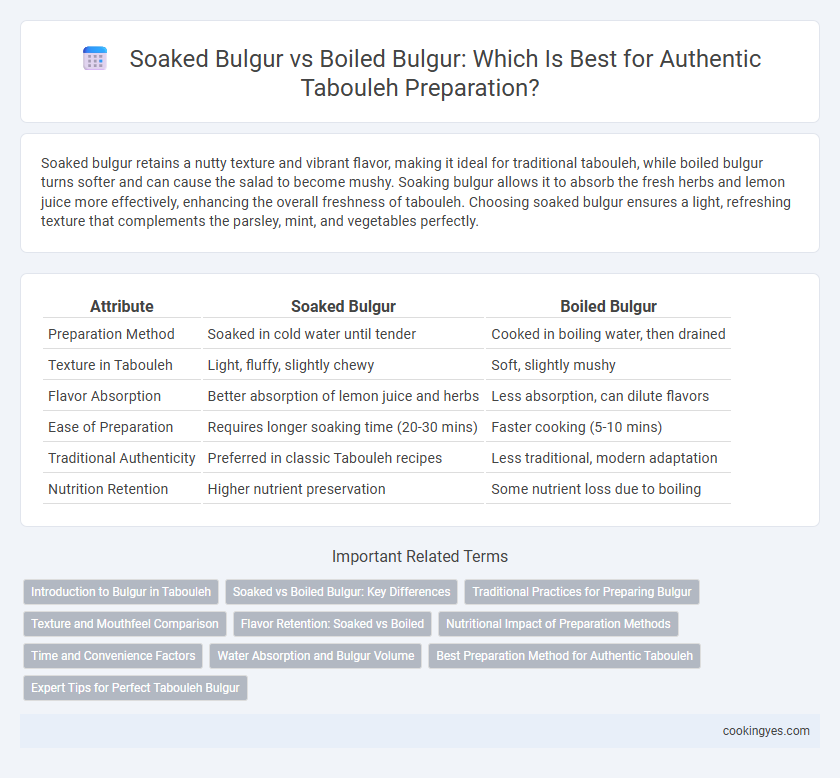Soaked bulgur retains a nutty texture and vibrant flavor, making it ideal for traditional tabouleh, while boiled bulgur turns softer and can cause the salad to become mushy. Soaking bulgur allows it to absorb the fresh herbs and lemon juice more effectively, enhancing the overall freshness of tabouleh. Choosing soaked bulgur ensures a light, refreshing texture that complements the parsley, mint, and vegetables perfectly.
Table of Comparison
| Attribute | Soaked Bulgur | Boiled Bulgur |
|---|---|---|
| Preparation Method | Soaked in cold water until tender | Cooked in boiling water, then drained |
| Texture in Tabouleh | Light, fluffy, slightly chewy | Soft, slightly mushy |
| Flavor Absorption | Better absorption of lemon juice and herbs | Less absorption, can dilute flavors |
| Ease of Preparation | Requires longer soaking time (20-30 mins) | Faster cooking (5-10 mins) |
| Traditional Authenticity | Preferred in classic Tabouleh recipes | Less traditional, modern adaptation |
| Nutrition Retention | Higher nutrient preservation | Some nutrient loss due to boiling |
Introduction to Bulgur in Tabouleh
Bulgur, a key component in traditional Tabouleh, is often prepared by soaking or boiling to achieve the desired texture. Soaked bulgur retains a firmer, chewy consistency and preserves more nutrients, making it ideal for the fresh, herbaceous nature of Tabouleh. Boiled bulgur becomes softer and more tender but may result in a mushier texture, which can dilute the signature freshness of this Middle Eastern salad.
Soaked vs Boiled Bulgur: Key Differences
Soaked bulgur retains a chewy texture and absorbs flavors gradually, making it ideal for traditional tabouleh where freshness and grain separation are essential. Boiled bulgur tends to be softer and slightly mushy, which can overwhelm the crisp herbs and vegetables in tabouleh. Choosing soaked bulgur enhances the salad's authentic texture and maintains the bright, fresh taste characteristic of classic Levantine cuisine.
Traditional Practices for Preparing Bulgur
Traditional tabouleh preparation favors soaked bulgur over boiled bulgur to preserve the grain's nutty texture and enhance the dish's freshness. Soaking bulgur in cold water softens the grains without cooking, maintaining the salad's light and fluffy consistency essential to authentic Middle Eastern recipes. Boiled bulgur tends to become mushy, altering tabouleh's signature balance of crisp herbs and bulgur, which is why soaking remains the preferred method in classic culinary practices.
Texture and Mouthfeel Comparison
Soaked bulgur in tabouleh offers a tender yet slightly chewy texture, preserving its nutty flavor and providing a more refreshing mouthfeel. Boiled bulgur tends to become softer and mushier, which can diminish the salad's characteristic grainy bite and crispness. Choosing soaked bulgur enhances the authentic texture contrast that defines traditional tabouleh, balancing softness and grain integrity for optimal sensory experience.
Flavor Retention: Soaked vs Boiled
Soaked bulgur retains a nutty, earthy flavor and a chewy texture, enhancing the fresh ingredients in tabouleh without becoming mushy or bland. Boiled bulgur absorbs more water and loses some of its natural taste, resulting in a softer, less distinct grain that can dilute the salad's overall flavor profile. Choosing soaked bulgur ensures better flavor retention, maintaining the crisp and vibrant character essential for authentic tabouleh.
Nutritional Impact of Preparation Methods
Soaked bulgur in tabouleh retains more nutrients such as vitamins and minerals compared to boiled bulgur, which experiences some nutrient loss due to heat exposure. Soaking preserves the grain's fiber content, enhancing digestive benefits, while boiling can reduce certain antioxidants and water-soluble vitamins like B-complex groups. Choosing soaked bulgur optimizes the nutritional profile of tabouleh, maintaining its health-promoting properties.
Time and Convenience Factors
Soaked bulgur retains a firm texture and requires only 15-20 minutes of soaking, making it a convenient choice for quick tabouleh preparation without the need for cooking. Boiled bulgur cooks faster, typically within 10 minutes, but requires active stove time and cooling before mixing, adding complexity to the process. Choosing soaked bulgur optimizes time efficiency and simplifies preparation, ideal for fresh, crisp tabouleh salads.
Water Absorption and Bulgur Volume
Soaked bulgur absorbs water gradually, maintaining a firmer texture and allowing for better control over the final volume, which is ideal for tabouleh's fresh, grainy consistency. Boiled bulgur swells quickly and tends to become softer and more uniform, increasing volume substantially but risking a mushy outcome. Water absorption rates differ significantly, with soaked bulgur retaining a balanced moisture ideal for the salad's crispness, while boiled bulgur often leads to overhydration and a less distinct tabouleh texture.
Best Preparation Method for Authentic Tabouleh
Soaked bulgur is preferred over boiled bulgur for authentic tabouleh preparation due to its ability to retain a chewy texture and nutty flavor essential for the dish's fresh and light profile. Soaking bulgur in cold water for 20-30 minutes preserves the grain's integrity and enhances the salad's overall crunchiness and taste. Boiling bulgur can result in a mushy texture, detracting from the traditional tabouleh experience.
Expert Tips for Perfect Tabouleh Bulgur
Soaked bulgur retains a light, fluffy texture ideal for authentic tabouleh, as it absorbs water evenly without becoming mushy. Experts recommend soaking fine bulgur in cold water for 15-20 minutes to preserve its nutty flavor and maintain the salad's fresh, vibrant consistency. Avoid boiling bulgur for tabouleh, as the heat can cause it to swell excessively, leading to a heavier, less delicate dish.
Soaked Bulgur vs Boiled Bulgur for Tabouleh Preparation Infographic

 cookingyes.com
cookingyes.com